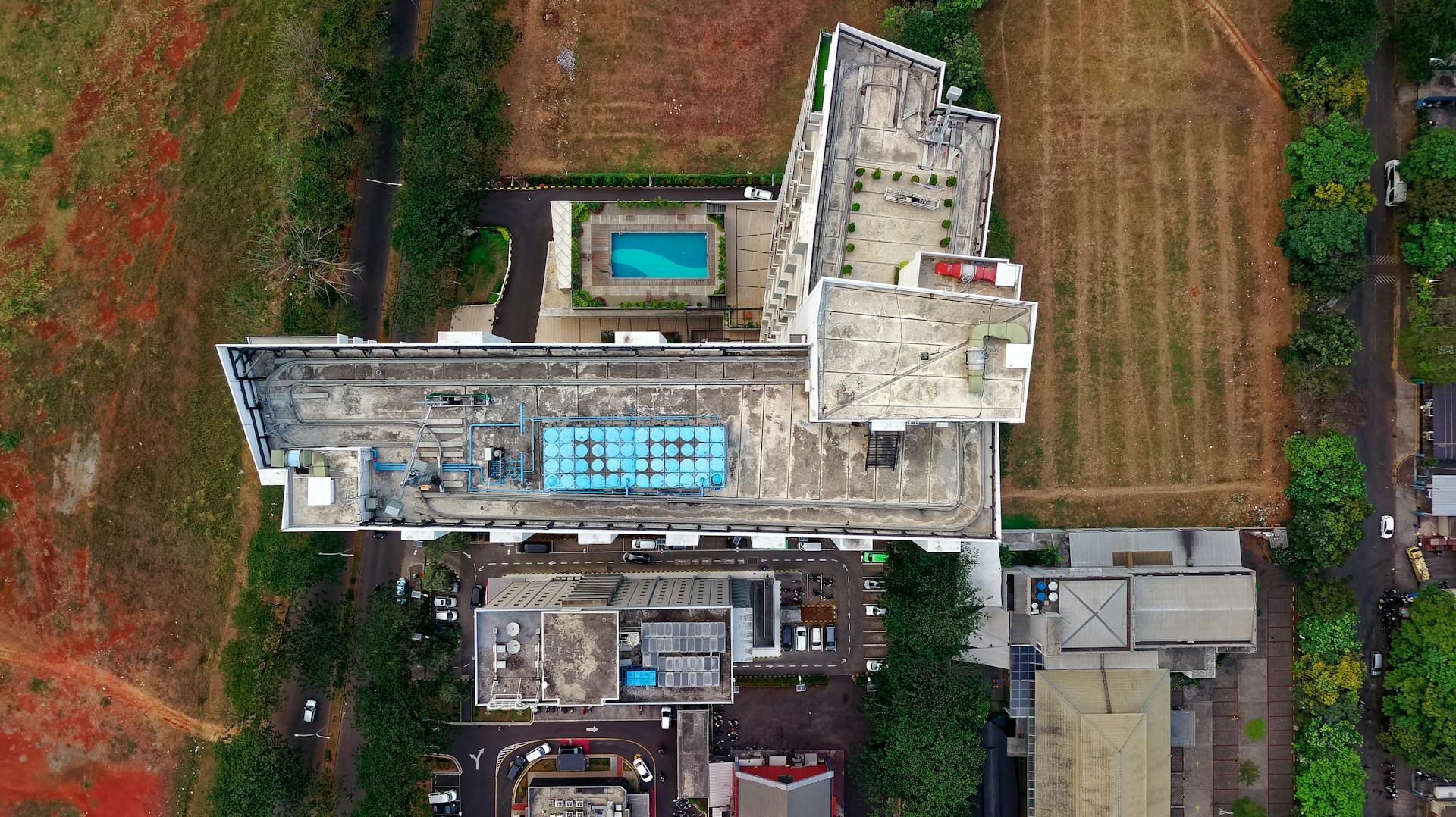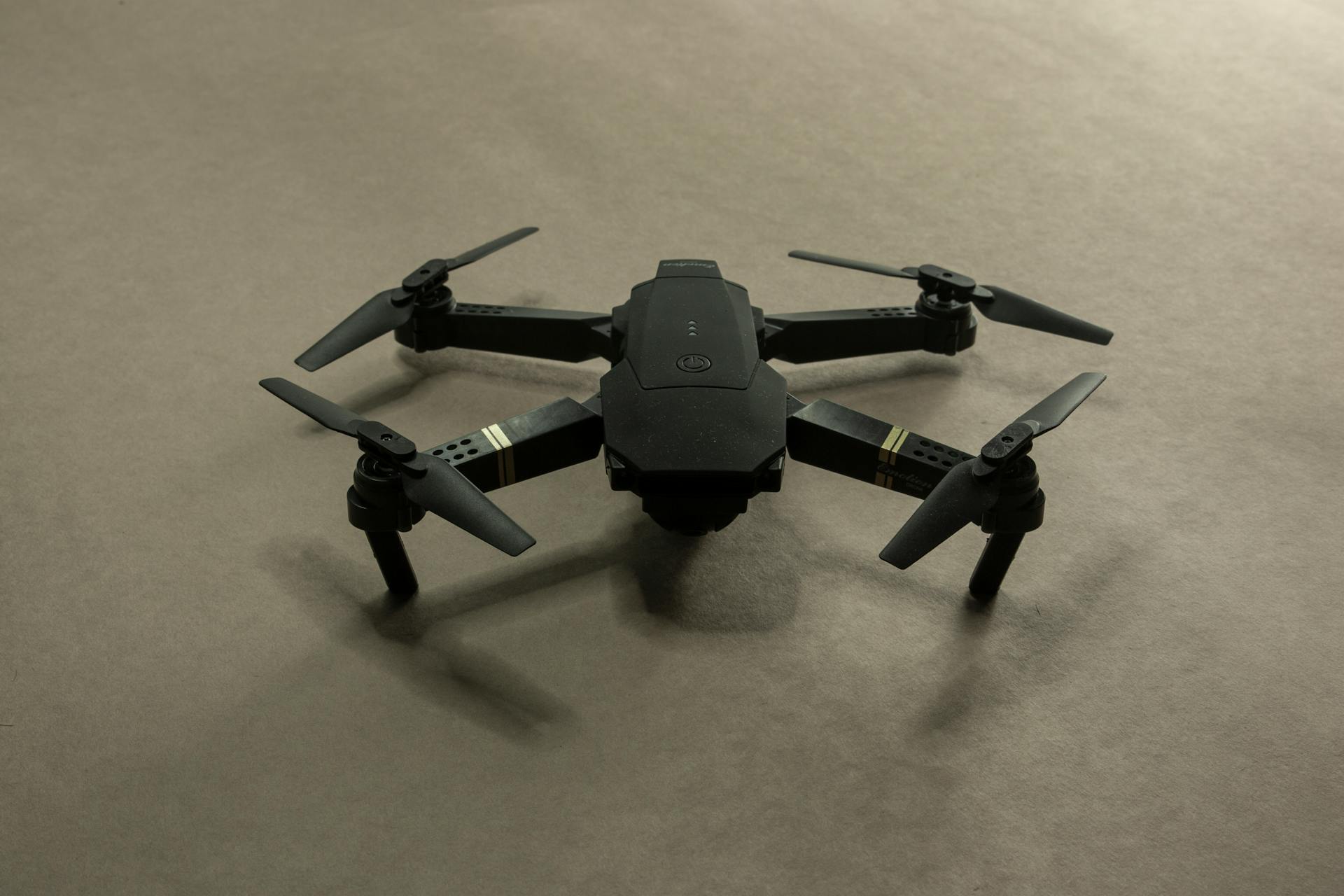
To become a remote pilot of small unmanned aircraft systems, you'll need to understand the regulations and guidelines set by the Federal Aviation Administration (FAA).
The FAA requires remote pilots to be at least 16 years old and able to read, speak, write, and understand English.
To get started, you'll need to register your small UAS with the FAA, which can be done online through their website.
You'll also need to pass a knowledge test administered by the FAA, which covers topics such as weather, airspace, and emergency procedures.
This study guide and resources section is designed to help you prepare for that test and become a certified remote pilot.
Readers also liked: Military Drone Pilot Salary
Study Guide
The FAA provides an official "Part 107 Aeronautical Knowledge Test Guide" that outlines the topics covered on the exam, including regulations, airspace, weather, performance, and safety. This guide is essential for anyone preparing for the exam.
For a more concise study resource, consider Tony White's "Part 107 Study Guide", which focuses on essential topics and offers clear explanations and practice questions.
A different take: Buyers Guide Balancer Harness
If you're looking for a comprehensive guide that closely follows the online Drone Pilot Ground School course content, the "Drone Pilot Ground School Study Guide" by UAV Coach is an excellent choice.
To supplement your studying, consider using an online Part 107 test preparation course, such as RemotePilot101, which includes numerous practice tests to help you gauge your readiness for the exam.
101
If you're looking for a comprehensive study guide for the Part 107 test, you've got several options to choose from. Tony White's "Part 107 Study Guide" is a concise and informative resource that covers the essential topics with clear explanations and practice questions.
Estimating the amount of material to study can be tricky, but Tony White suggests around 550-600 pages of material to cover. You should plan your study schedule accordingly, allowing enough time to go through the material.
One key aspect to keep in mind is that passing the Part 107 exam is just the beginning. It's essential to find quality mentorship after passing the test to help you apply your knowledge in real-life situations. A competent flight instructor can help you become profitable, legal, and safe in your drone operations.
Curious to learn more? Check out: Dji - Mini 2 Se Drone with Remote Control
To get started, you'll need to sign up for the test and familiarize yourself with the Airmen Certification Standards (ACS) and Part 107 ACS. RemotePilot101 offers an online test preparation course with practice exams that mimic the real test, allowing you to assess your knowledge.
Here are some steps to help you stay on track:
- Estimate 550-600 pages of material to study
- Sign up for the test and familiarize yourself with the ACS
- Use RemotePilot101's online course for practice exams
- Set clear goals and create a study schedule
- Find quality mentorship after passing the test
Drone Ground School Study Guide
If you're looking for a comprehensive study guide to help you prepare for the Part 107 Knowledge Test, you have several options to choose from.
The FAA provides an official "Part 107 Aeronautical Knowledge Test Guide" that outlines the topics that the exam will cover, including regulations, airspace, weather, performance, and safety. This guide also includes sample questions and answers to help you become familiar with the test format.
The "Drone Pilot Ground School Study Guide" by UAV Coach is a companion to the online Drone Pilot Ground School course and is a comprehensive guide that closely follows the course content. However, it can also be used as a standalone study guide.
Explore further: Dji Phantom 3 Standard User Guide
Here are some key topics that you should focus on when preparing for the Part 107 Knowledge Test:
- How to register for the relevant certifications required to operate a drone or UAS
- How to operate an sUAS in accordance to FAA regulations
- How to register with the FAA
- Understanding commercial restrictions
- sUAS operation limitations
- Nighttime operations
- Operations over people
- Hazardous flight operations and altitudes
- Radio communications
- Weather and meteorology
- Accident reporting
- Best practices and responsibilities of a drone pilot
- Visual line of sight operations
- Right of way rules and flying over people
- METAR report and TAF report
- Stages of thunderstorm and cloud formation
- Airspace classifications
These topics are covered in the FAA's "Part 107 Study Guides" which are available for free download on the FAA website.
You might like: Faa Approved Drone Remote Id Module
Preparation and Resources
To prepare for the remote pilot small unmanned aircraft systems study guide, consider enrolling in an online course or training program. King Schools' Drone Pilot License Test Prep Course is a great option, as it covers topics ranging from regulations to safety procedures in a clear and concise manner.
Online courses and training programs are one of the most effective ways to prepare for the Part 107 Knowledge Test. These courses are designed to cover all the required topics in-depth and often include interactive lessons, practice questions, and quizzes.
The Pilot Institute offers an online Part 107 Test Prep course that provides a comprehensive understanding of the regulations, airspace, weather, and other topics covered in the exam. The course also includes practice tests to assess your knowledge and readiness.
Take a look at this: Remote Drone Pilot
You can also use a comprehensive resource like the "Remote Pilot Test Prep 2021" book by ASA. It includes explanations, sample questions, and detailed answers, and comes with a test supplement for practice.
Drone Pilot Ground School is another excellent online course created by UAV Coach. It covers all the essential topics required for the Part 107 Knowledge Test, including regulations, weather, airspace, and much more. It also offers practice quizzes and simulated exams to gauge your readiness.
The "Drone Pilot Ground School Study Guide" by UAV Coach is a companion to the online course and a comprehensive guide that closely follows the course content. It's an excellent choice for those enrolled in the program, but can also be used as a standalone study guide.
Reddit's drone-related subreddits, including r/drones and r/UAV, are great communities to seek guidance and answer questions related to Part 107 preparation and drone operation.
Certification and Licensing
To become a certified remote pilot, you'll need to pass the Part 107 exam, which is outlined in the FAA's "Remote Pilot - Small Unmanned Aircraft Systems (sUAS) Airman Certification Standards" document.
This document provides a comprehensive understanding of the knowledge areas and areas of operation you'll need to be proficient in to pass the exam.
King Schools offers a Drone Pilot License Test Prep Course, which is structured to prepare you for the Part 107 Knowledge Test and covers topics ranging from regulations to safety procedures.
The course uses a clear and concise teaching style to make complex topics easier to understand.
To get started, you'll need to familiarize yourself with the regulations, including the operation and certification of small unmanned aircraft systems, which is outlined in a 2016 FAA rule.
Here's a brief overview of the key points to know:
- The FAA is the agency responsible for issuing and signing documents related to small unmanned aircraft systems.
- The FAA has amended several parts of the Code of Federal Regulations (CFR) to include rules for small unmanned aircraft systems.
- The FAA has assigned a RIN (Regulatory Information Number) of 2120-AJ60 to this regulatory action.
With this information, you'll be well on your way to becoming a certified remote pilot and getting ready to take the Part 107 exam.
Learning and Tips
To effectively learn and master remote pilot small unmanned aircraft systems, it's essential to understand the importance of pre-flight planning. This involves reviewing weather forecasts, airspace restrictions, and aircraft performance to ensure a safe and successful flight.
A key aspect of pre-flight planning is understanding the different types of weather conditions that can affect small UAS operations. As mentioned earlier, wind, precipitation, and temperature are all factors that can impact flight safety and performance.
When conducting a pre-flight inspection, pilots should check for any damage or malfunctions that could compromise the aircraft's performance. This includes inspecting the propellers, motors, and control surfaces for any signs of wear or damage.
By following these steps and staying up-to-date with the latest regulations and best practices, remote pilots can ensure safe and successful small UAS operations.
If this caught your attention, see: Small Dash Cam
Taking Tips
Make sure you have a current supplement legend before taking the test. This will help you answer questions that are clearly answered in the legend.
Don't be afraid to think outside the box and consider the "spirit of the question" rather than just the literal wording.
Keep in mind that the answers to one question can often help you figure out the answer to another. Sometimes, the questions and answers further down the test will provide the answers you need.
Write down everything you think you'll forget on a scrap piece of paper at the start of the test. This will help you clear your mind and focus on the questions.
Try to answer a question before reading the possible answers. This will help you avoid being tricked by slightly different answers.
Eliminate the obviously incorrect answers first. You don't have to find the correct answer, just get rid of the ones that are clearly wrong.
Read the test questions and answers carefully. It's easy to overlook something important if you're not paying attention.
Here are some tips to help you stay focused and refreshed during the test:
- Sleep for 8-10 hours before the test to ensure you're well-rested.
- Eat a nutritious meal before the test to give you energy.
- Take the test in the morning, around 10AM-12PM, to avoid rush hour traffic.
Trouble Learning Material?
If you're struggling to learn the material for the remote pilot knowledge exam, don't worry, all the necessary information is available on this page.
The online training courses on Rupprecht Drones can help speed up the learning process. These courses are designed to provide a comprehensive understanding of the material.
The Part 107 Regulations Online Training Course, for example, consists of 40 videos and 35 quizzes, totaling over 100 questions. This course is perfect for those who want to quickly grasp the regulations.
Night flying can be hazardous, and the Night Operations Online Training Course is designed to help you identify the associated risks and their remedies.
Consider reading: Unmanned Aircraft Systems Training
Sources
- https://www.av8prep.com/aviation-library/part-107-drone/part-107-study-resources-and-recommended-materials
- https://www.federalregister.gov/documents/2016/06/28/2016-15079/operation-and-certification-of-small-unmanned-aircraft-systems
- https://jrupprechtlaw.com/part-107-test-study-guide/
- https://wingsandwheels.com/asa-remote-pilot-small-unmanned-aircraft-ebook.html
- https://thedronecoach.com/faa-part-107-remote-pilot-study-guides/
Featured Images: pexels.com


